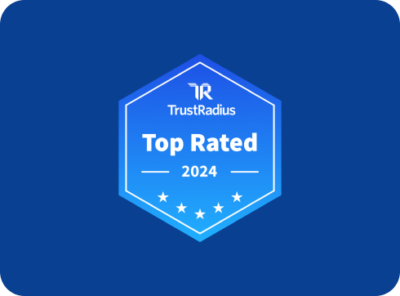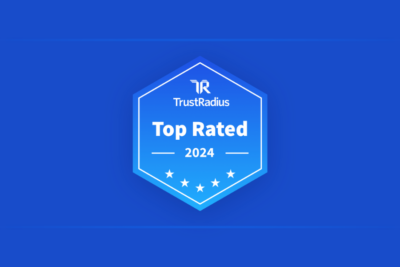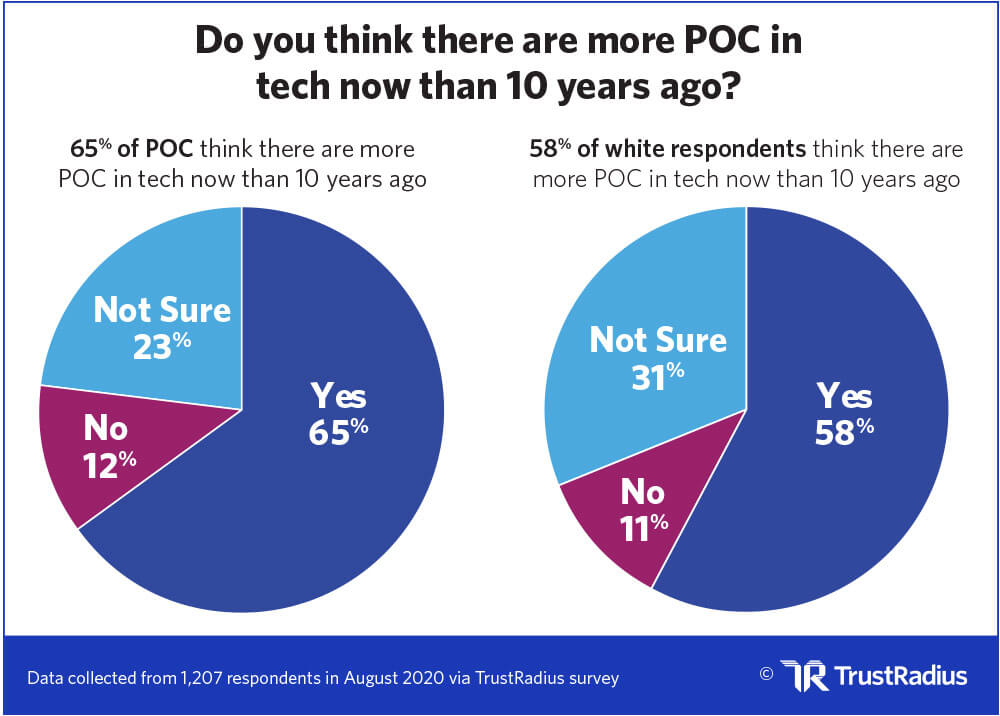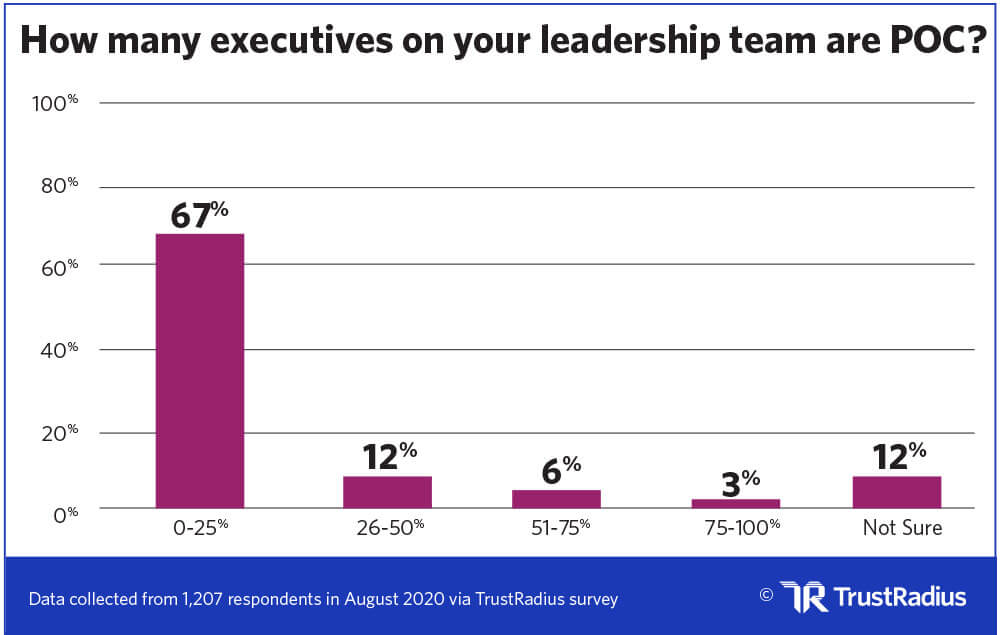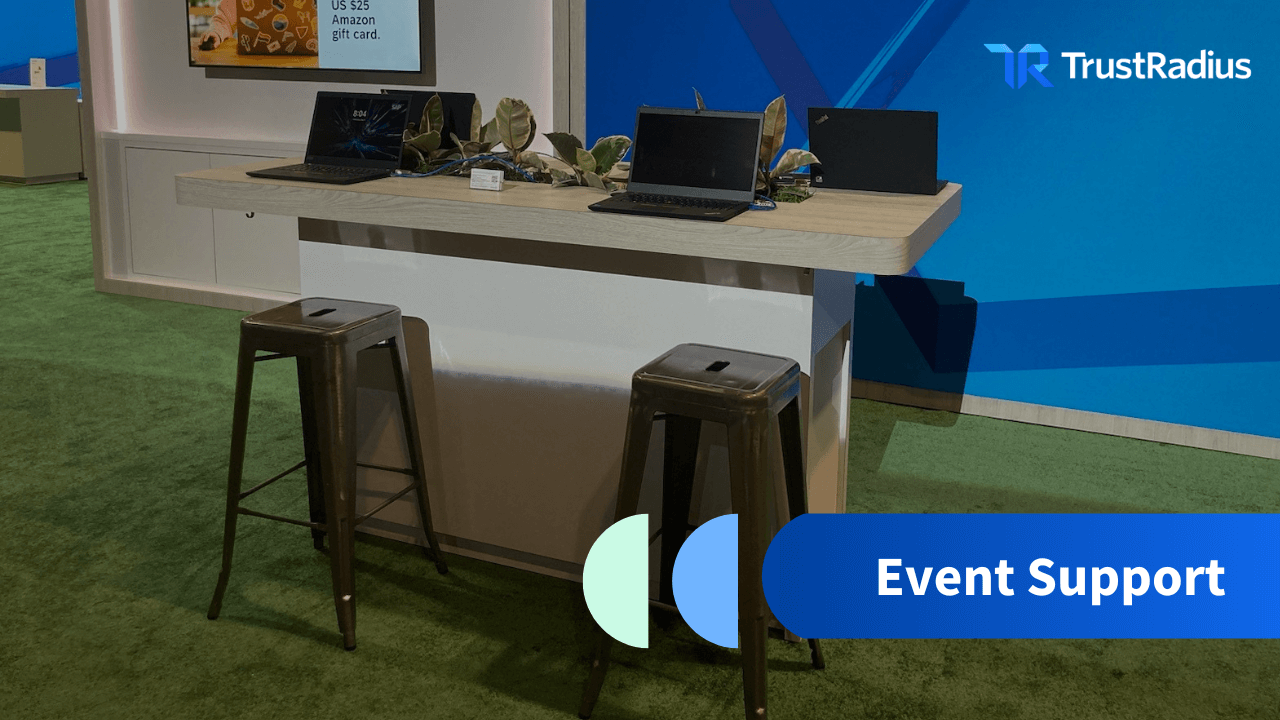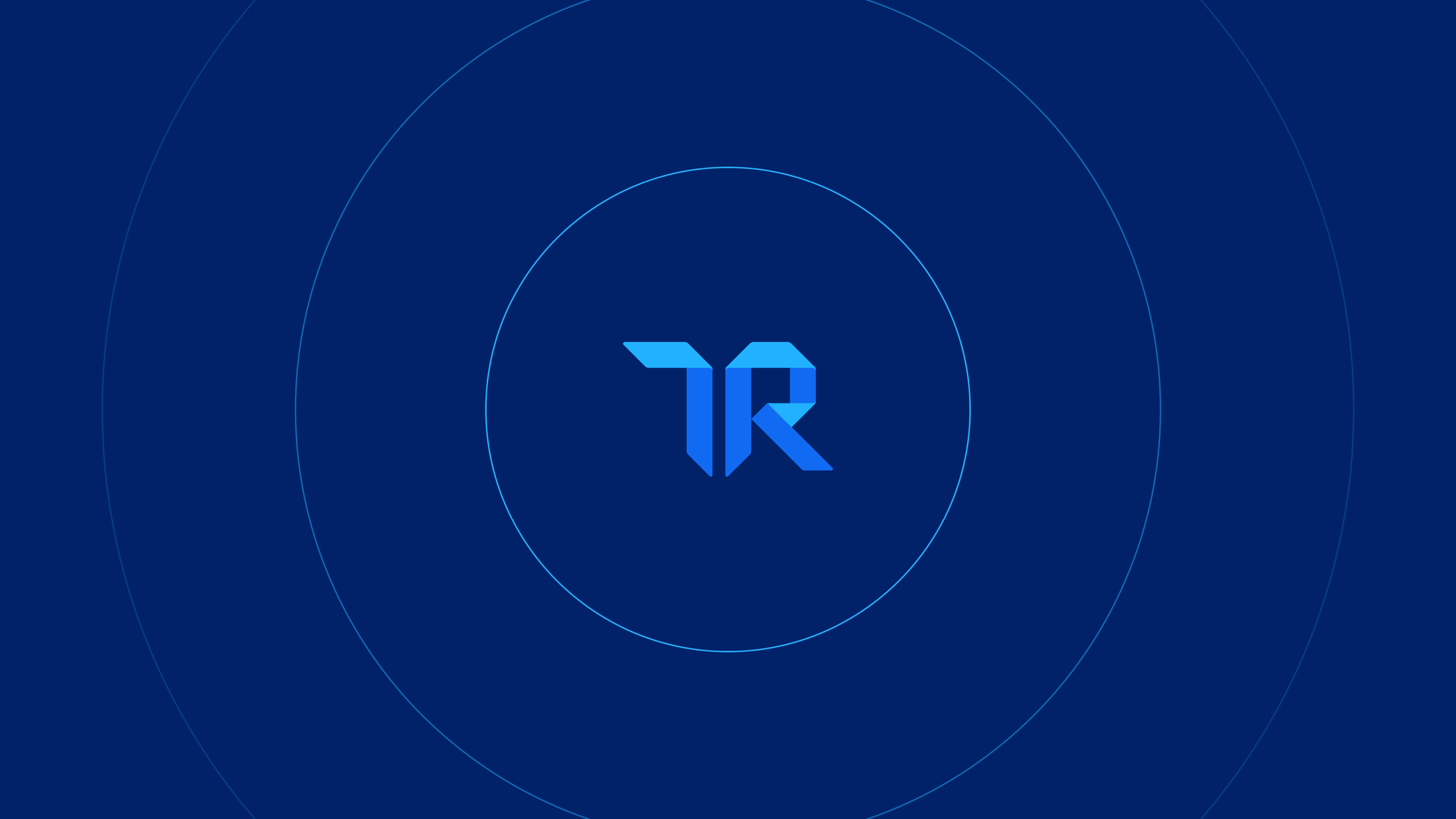How Matt Stephenson Launched a Nonprofit to Get More Students of Color Into Tech
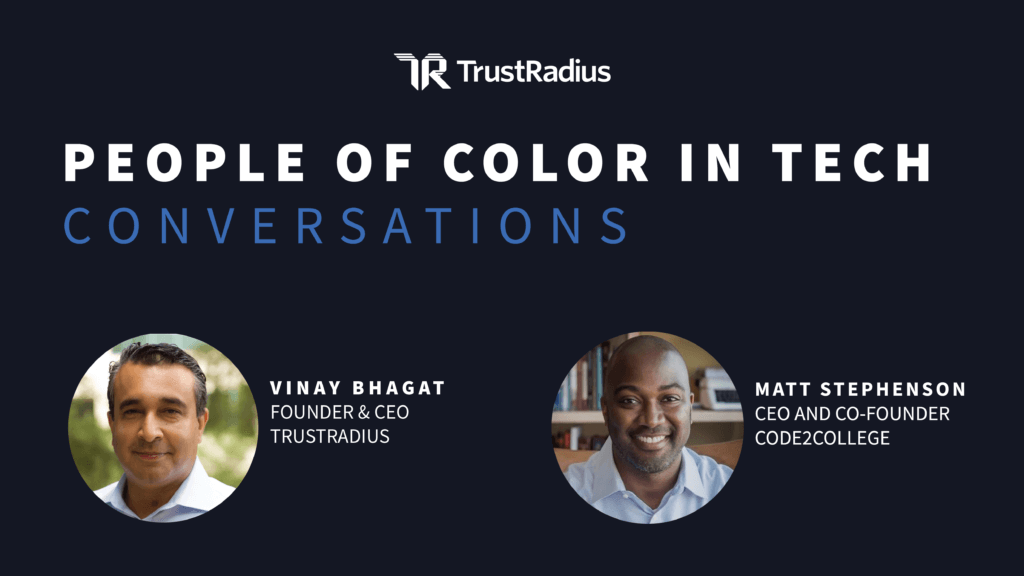
When we published the first annual People of Color in Tech Report in September 2020, we knew our readers would get a ton of value from hearing the stories of tech leaders straight from the source.
Today the People of Color in Tech Conversations series continues with an inspiring conversation with Matt Stephenson, CEO and Co-Founder of Code2College.
In this exclusive interview with TrustRadius CEO Vinay Bhagat, Matt shares how he started a nonprofit to get more minority and low-income high school students into STEM fields.
Key Takeaways From This Conversation
- Many students of color require access and exposure to tech careers
- Companies should get excited about high school internship programs.
- We need to hire for “culture add,” not “culture fit.”
Listen to the Conversation Here:
Click here to view a transcript of this Conversation.
Understanding the Lack of Visibility
Big thanks to Matt Stephenson for sharing his story and insights for the People of Color in Tech Conversations series.
Matt built Code2College on several key principles—one of which is, “If you can’t see it, you can’t be it.” Visibility and access are therefore crucial priorities for helping students of color imagine a future in tech.
According to new research in the People of Color in Tech Report, we’re seeing more people of color in tech today than we did 10 years ago. That’s a step in the right direction, especially because this view seems to be shared by people of color and their white peers.
However, we still have a lot of work to do. According to one survey respondent:
“The biggest challenge for POC in tech right now is the lack of representation and leadership that reflect us. I’ve worked within the industry for 11 years and have had 2 black co-workers who were on a related team, and zero black co-workers who worked on my team. Thinking about IT or extended tech teams, I’ve worked with a total of 5 black males and ***1 black female.
I’ve worked with HUNDREDS of people directly related to technical teams considered when presenting those numbers and I’ve only worked with a total of ***6 black people. I tend to feel slightly like an outsider, with a minor consideration of my differences that most people I work with never consider.”
– POC survey respondent
As they mentioned, we’re still seeing a huge lack of people of color in leadership positions. Only 21% of tech professionals work at companies whose leadership teams are more than a quarter POC. 67% say their leadership teams are 25% or less POC. 12% are not sure.
Another survey respondent explains the exact challenge Matt is trying to solve:
“To be general, the biggest challenge is building POC awareness of the tech field. With most of our parents being blue collar workers, it is rare for POC to even choose these career paths from the beginning. As I mentioned before, we are pushed toward blue collar jobs at an early age and most are unaware of these career options.
I am a first-generation college student with a single mother who was a corrections officer. The process of even beginning to apply for college was quite isolating and overwhelming. I never really understood my career options until my junior year of college. We really need more people reaching out to POC youth about the tech field.”
– POC survey respondent
Programs like Code2College are doing just that. Matt and his team are working hard to fuel the talent pipeline that (hopefully) will result in more executives of color very soon. We’re grateful to Matt for sharing his story, and for doing such important work in our Central Texas community.
To learn more about these issues, read the full TrustRadius 2020 People of Color in Tech Report. Then take action and start having conversations with your colleagues, employees, and friends. Together we can make a difference.
Conversation Transcript
How Matt Stephenson Got Into Tech
Vinay: As a starting point for this interview, I’d love to hear about your background and how you got into the tech industry.
Matt: Sure. So my background is in finance and information systems. I graduated from the Stern School of Business at NYU a number of years ago, and at the time I found a passion for coding. It was just highly logical, yet you still had the opportunity to be creative and explore problem solving. It was at a time when coding was not yet sexy or at least not as sexy as it is now. Finance definitely was.
So I definitely pursued a career in finance while also using coding to help defray the cost of attending school. I was a webmaster for the company that my college girlfriend worked for. I did several coding projects on the side. I even picked up VBA or Visual Basic for Applications and that made me a standout once I joined Goldman after college. That was my path into tech and computer science. It was always there even though it wasn’t a primary focus of mine.
But then I recognized that there were such low barriers to entry. And I always kept in the back of my mind that I wanted to figure out how to leverage the skills of those who were passionate about exposing students to computer science, while also realizing the potential with such low barriers to entry for the field.
How Code2College Began
Vinay: Tell us a little bit about Code2College. What’s your mission? How do you operate today? Where across the country do you operate?
Matt: At Code2College, our express mission is to dramatically increase the number of minority and low-income high school students who enter and excel in STEM undergraduate majors and careers. STEM is an acronym for science, technology, engineering, and mathematics.
In our program model, we source skills-based volunteers from about 60 companies including Google, Atlassian, VMware, and more. They deliver after-school coding and web development education to our students twice a week throughout the semester.
Students also attend a variety of professional skills workshops and STEM industry competitions to gain context and familiarity with the industry. And a growing number of our high school students ultimately are placed into paid summer internships with leading tech companies in software engineering, software development, IT, and other roles.
We operate primarily in Central Texas or the Greater Austin area, but we’ve since launched programming for students in Philadelphia and San Antonio this semester.
Vinay: You’re obviously doing some fantastic work. But what gave you the courage to start Code2College? You had a nice, stable job at Goldman Sachs, and a lot of people would be very happy with that path in life. What made you take a risk and start Code2College?
Matt: So, my family is from Jamaica. And culturally, Jamaicans are quite entrepreneurial. Some would say that they don’t like being told what to do, so they ultimately become their own bosses oftentimes. My father is an entrepreneur. He has still, to this day, his own insurance brokerage. And entrepreneurship was always in my blood.
While I had a great experience at Goldman learning a lot about the capital markets and a lot about risk management, I wanted to find a way to truly serve my community in a meaningful way. I knew that I had a great idea that if executed well, would have a significant impact on the community.
This idea of Code2College was being de-risked and incubated for almost 20 years. And even though it’s only been in operation for four years, I’ve been working on this effectively for quite some time.
Major Challenges Faced By People of Color in Tech
Vinay: So, let’s fast-forward to today. What are the biggest challenges that you see that still remain for people of color in the tech industry?
Matt: I would say access is one of them. You know, I look at my own background and will say that a number of the opportunities that I’ve had as well as the inroads that I’ve been able to make for Code2College are because of the networks that I’m a part of—Goldman, Wharton, where I got my MBA, and Stern, where I got my undergraduate degree.
These are all highly valuable networks that have afforded me a great deal of access. And not everyone has access to those networks because there are a variety of structural barriers and institutional barriers that prevent a great number of people of color from entering these networks. The same is the case for tech.
If you can’t see it, you can’t be it. That’s something we say often in our organization. And we try to expose our students to as many industries as possible.
Because if your father wasn’t an engineer, if your mother wasn’t a physician, you know, there are so many industries that students just don’t know about.
You have to make decisions about your future and your academics as early as elementary or middle school sometimes in order to pursue many of these fields. And if you don’t have anyone in your sphere or your network who occupies any of these careers, you wouldn’t know that.
That’s why we think access and exposure are two of the main factors.
And I would also say socioeconomic status. There are so many opportunities that students have for enrichment that if you don’t know about them, you’re not held on equal footing with those who have that access as well.
Advice For Tech Professionals of Color
Vinay: You focus very astutely on the challenge of getting more people of color into the tech industry. What are the issues you’ve seen for people who have landed jobs in the tech industry? What structural changes are still required once people are in?
Matt: You know, we believe in this principle of “at bat.” And what that means is having low-stakes opportunities to fail. This aligns with that lack of exposure and lack of a network. If you don’t have the network or the access and you’re not familiar with the fact that you will fail a lot and gain comfort with that, I think the mental bar for many professionals of color can be so high. Your growth is almost like arrested development as a professional.
Traditionally, white male peers have been given more opportunities to fail. Those opportunities promote risk-friendly mindsets, ambitious goal-setting and greater relative outcomes. The perception that these counterparts are higher-performing professionals is about disproportionate access and support, not ethnic or demographic background.
I would say that mentorship is key. Having someone who has been there before, who is able to coach you and provide insight and let you know that this is absolutely normal… that’s huge.
Continuing education as well. I think a lot of professionals don’t recognize that, yes, you’ve gone to undergrad and you got your schooling there and now you’re working. But some of the most successful professionals I’ve ever met, they’re just lifelong learners.
They are taking classes outside. And when I say taking classes, I don’t mean necessarily signing up for continuing education at Austin Community College or anything that you have to pay. I mean, they’re picking up books and they’re constantly sharpening the saw. If they’re a technologist or an engineer, they’re reading up on new frameworks. They’re also joining technical meetups and speaking with other professionals so that they can share knowledge, learn more about the industry, and gain more context.
Once you get into a profession or once you get into the workforce, it’s not game over. It’s just begun. You have to be a sponge, and it’s an active sport. You’ve got to be out there and constantly improving yourself.
How the Tech Industry Needs to Change
Vinay: What are the structural or cultural changes you’d like to see happen in the tech industry in the next three to five years?
Matt: Selfishly for Code2College, I can say that I want this idea of a high school internship to become popularized and socialized a lot more.
Frankly, whenever I have initial conversations with a hiring manager or a senior executive at a company who is just learning about our organization… You put “high school” and “internship” in the same sentence and you start to hear them dry-heave.
While it’s a fun concept, typically people (especially hiring managers) think of internships as a conversion tool to get undergraduates to full-time employee status. But this is an opportunity to invest in the future. Irrespective of the fact that these are students of color, you get a chance to meet a student or a future employee five or six years before you would typically meet them and invest in them.
And five years later, which I know is a very long time frame especially for someone who is series A or series B as a VC-backed executive… It’s just a great way to invest in your talent pipeline. It’s a great signal for your employees, and in particular your employees of color, that you’re not just talking the talk. You’re walking the talk.
And frankly, the dividends pay off significantly. Four years in, we now have seen this with our partners who have been investing in this type of programming. I want to see more comfort with investing earlier in the pipeline.
I’d also say that we need an orientation towards “culture add” versus “culture fit.”
So, it’s not about, “Well, this is the culture that we have. So we’ll hire you as long as you fit within that culture.” At Code2College, we have a team of six. And I’d like to double the team over the next quarter or two. If we’re looking for six more people who just fit in within our culture, you talk about arrested development. That would be such a stymie to our growth as an organization. There’s so much that we don’t know and there’s so much that we can learn from others. So we want people to add to our culture.
I think that type of orientation versus the stodgy, conservative, “This is just the way that we’ve done things and we want people who can fit into that mold or else talk to somebody else,” I mean, that’s a losing mentality for any employer to have.
Vinay: What advice would you give to young professionals of color looking to join the tech industry today?
Matt: The barriers to entry are low. You can do it. There’s no one way to start, and there’s no one way to continue. This is iterative. So, you will fail, and I encourage you to fail often. That is how you will succeed.
Vinay: Any other closing comments you’d give to young professionals out there? Or perhaps even to companies that feel like they should be doing a better job in this area?
Matt: I would say, seek out organizations that have been operating for a time. Do your due diligence, but look for organizations who have been doing this work.
I see a lot of companies who have the financial resources and they’re throwing capital and volunteered time at figuring this out, especially this year in 2020. Whereas, there are organizations who have been doing this primarily or sometimes exclusively for years. Trust the experts. If this is a priority, just like any other business priority, you would look for the experts and you would hire them for it.
Rather than allocating a slim budget and asking employees to volunteer their time at it, treat it like a business priority if it is a business priority. Otherwise, be honest with yourself and your employees and say, “It is not a business priority. It is a nice-to-have.”
Vinay: Matt, thank you for sharing your advice and perspectives. Kudos for the great work that you’re doing with Code2College and the impact you’re having on many, many high school and college kids. Again, thank you for joining us today.
Matt: And thank you, Vinay. And thank you for volunteering with Code2College.
Vinay: Delighted to do so. Happy to try and make a difference in the small way that we may. Matt, thank you once again.


